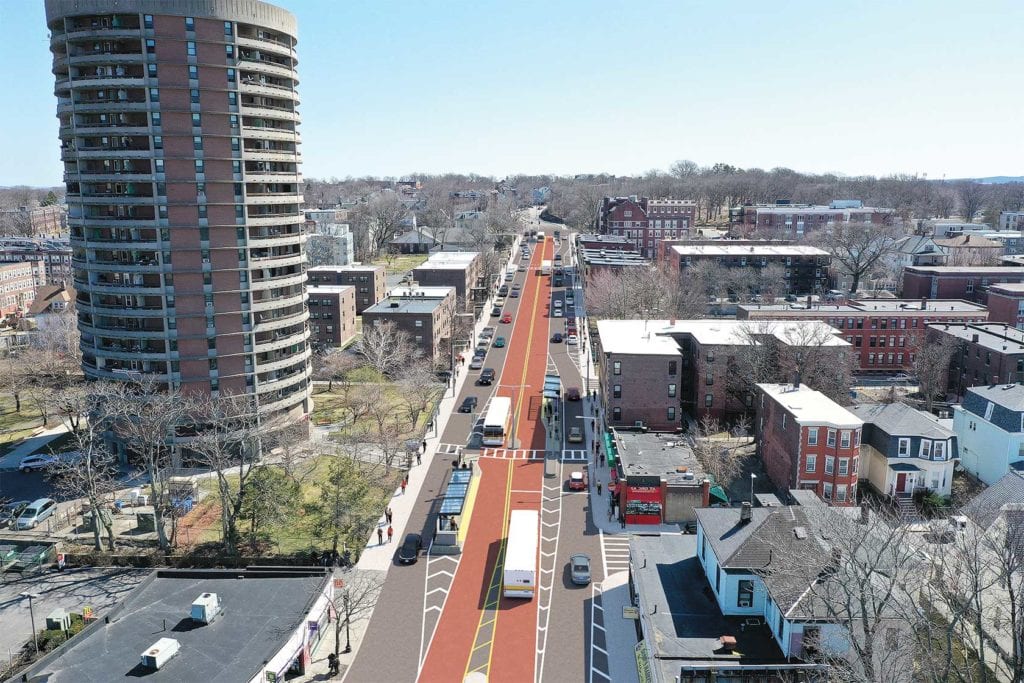State begins construction on Columbus Ave. bus lane.
Auto traffic will be reduced to one lane in either direction

The city broke ground on Columbus Avenue this week in a project that puts bus lanes in the center of the street and limits the amount of vehicular traffic. Though Boston is also working on several bike corridor projects, this one will not include bike lanes, and will remove some of the on-street parking.
Businesses and residents in the Egleston Square area will be most affected, and many have spoken out in support of the project’s claims of increased safety and bus route speed.

Parking spaces will be removed and traffic reduced to one lane at the intersection of Columbus Avenue and Washington Street in Egleston Square. SCREEN GRAB
Denise Delgado, executive director of Egleston Square Main Street, says business owners are informed and see the development as positive.
“I think that stretch of [Columbus Ave.] is really pretty dangerous for the folks that are walking, for pedestrians … there are two facilities for people who are elderly [nearby],” she said, referring to the Walnut Park elderly housing tower on Columbus Avenue and the Cooper House elderly housing complex on Walnut Avenue.
Delgado is looking for the construction to bring more customers on the bus from Ashmont and Nubian Square. She said there hasn’t been concern about losing customers due to lack of parking and noted that city officials had conferred with area businesses on multiple occasions.
“William Moose from the department of transit came on several occasions. He did a walkthrough with folks from [Egleston Square] Main Streets and the neighborhood association, and with Urban Edge,” she said. They also held merchant meetings, she said, where Moose presented the project to Spanish-speaking business owners.
Following the notion that center-running bus lanes speed up travel times for passengers, the project allows for them to board the bus in a dedicated center bus lane with a single lane for vehicles on either side.
According to a press release, the crosswalk was also known to be unsafe.
“In 2019, there were twenty-five reported crashes along the project corridor, and four of those crashes involved pedestrians,” the release reads. The new lanes will run from Walnut Avenue to Jackson Square with stops for bus routes 22, 29 and 44, which all serve large numbers of low-income and non-white riders, according to the MBTA.
The city also led outreach with adjacent neighborhoods, starting in December 2019 and continuing through mid-August with virtual meetings. In addition to meetings with business leaders and tenants, the Boston Transportation Department also met with the Boston Cyclists Union, whose members previously argued that bike lanes should be prioritized over parking spaces.
Bike lanes were not included in the plan. According to a BTD spokesman, the number of buses and the inclines on the road would cause too much conflict with buses and bikes.
In response, a bike shop owner gathered about 20 riders on Aug. 26 to bring attention to the lack of safe lanes. Jeffrey Ferris, owner of Ferris Wheels Bike Shop in Jamaica Plain, attended the city’s presentation on the project in January and said the plan appeared to be finalized already.
“It appears they prioritized parking cars over a bike lane,” Ferris said. When trying to see if the shared bus and bike lanes seen on other streets would work, “They didn’t address that with the community, they just went right to the center thing,” he said.
The city’s concern for Columbus Avenue is clear in their PLAN: JP/ROX initiative, the JP/Rox Transportation Action Plan, and Go Boston 2030, which included a “complete streets” project that aims to put people walking, biking and taking transit on equal footing with people driving. Ferris says this project abandons that initiative.
“If they didn’t come up with a complete design, then don’t say we’re done,” he said.
Louis Elisa, a resident living near the future bus lanes said that neither the city nor the state met with the Garrison Trotter Neighborhood Association, and he didn’t have a chance to voice his concerns.
“They’ve done nothing to change the flow of traffic. There will be the same amount of cars on Columbus Ave., and they’ll be there for a longer period of time,” he said.
BTD did not meet directly with the Garrison Trotter Neighborhood Association but held six public meetings in English and Spanish.
Another project is expected to bring buses to the center on Blue Hill Avenue, where the city has planned several more meetings to engage the community. State Rep. Russell Holmes said the change is long overdue. The area could have received about $175 million from the American Recovery and Reinvestment Act in 2009, but residents rejected the project at that time because they felt “like this project was being thrown on them,” he said.
“I just felt like, from my perspective, as a citizen, the job of a politician is to bring money to the district not to be taken away,” he told the Banner.
“I’m very pleased that we are focusing on something that we knew more than 10 years ago, should have already been done … This improvement is the first step towards getting back to the $175 million that we had 10 years ago,” Holmes said.
Through the first few meetings, BTD has received a significant number of requests to maintain the trees on Blue Hill Avenue, add crosswalks and bike lanes, and improve bus priority measures.






